
Everyone can be a runner. There will always be those who seem to be faster and to glide along effortlessly.
Many new runners feel embarrassment - that they are too old, too fat or too unfit to run. Ignore to those voices in your head.
Running can help to make you feel + look healthy. It can help improve your mood, positivity, health and confidence in different ways. Weight loss need not be the only goal so focus on your improving physical fitness rather than on just the calories consumed.
Runners will tell you that nothing beats that post-run feeling of positivity, energy and invincibility, alertness, de-stressed, strength and self-confidence as your fitness improves. You are likely to eat, sleep and think better.
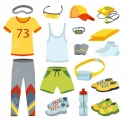
You don’t need much!
You need a good pair of running shoes and running socks.
For clothing you don't need technical gear - something loose and comfortable in a breathable material.
If you keep on running some specialist clothing would be a good investment.
Women should use a sports bra. It will reduce breast movement by around 55%.
What to Wear

Good Running Form or Technique
1. Keep your head straight: Look straight ahead of you and avoid looking down at your feet. Keep your jaw and neck relaxed.
2. Don't hunch your shoulders: Keep your shoulders be back, down + relaxed. Don't hunch over as this restricts breathing.
3. Keep your hands relaxed but not flopping.
4. Keep your arms bent at 90’ at the elbows + swing them forward and back - not across your body.
5. Lean the whole body slightly forward while running but don’t bend from the waist. Some suggest a very upright posture but this is less effective going forward..
6. Keep your hips stable and forward-facing. Don't stick your bottom out or rock your hips from side to side.
7. Don't lift your knees too high: Land with a slight bend in the knee. Avoid bouncing up and down too much.
8. Aim for a mid-foot strike - this the safest way to land for most recreational runners - and not too far out in front.
9. Don't strike the ground too heavily. Aim for short light steps as they are efficient and less stressful on the body. Good running is light and quiet.
10. Breathe deeply and rhythmically: Try to breathe deeply and rhythmically. Aim for one breath for every two strides.
It’s important to have energy + to be hydrated for your runs.
Avoid having a large meal within two hours of your run. You need blood to be in your muscles, not your digestive system!!
To lose weight remember that the total fuel must not exceed the fuel being burned by your total normal daily activity. Long (>45 mins) steady, moderate intensity exercise tends is better for burning stored fat.
Provided you are drinking enough throughout the day recreational runners should not need to carry water. On longer runs some people like to have a water bottle with them while running but sip rather than gulp. You should drink before you become thirsty.
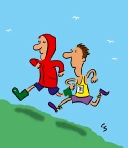
Eating and drinking

This link is to some podcasts that will guide you through a ‘Couch to 5 Km' - C25K programme
For the runs in Week 1, you will begin with a brisk 5-minute warm-up walk, then you will alternate 60 seconds of running, with 90 seconds of walking, for a total of 20 minutes.
C25K graduates wanting to do more see this link and for Strength and flexibility podcasts click this link
Running with large breasts can embarrassing but it can also be painful and can affect your running technique.
Excessive movement can cause problems. The top three complaints from well endowed female runners include .
Back Pain
Large breasts can pull your upper trunk forward into a hunched-over running posture. This will decrease your stride efficiency and increase injury risk. If the bra straps are too thin they will dig into the top of the shoulders and may injure the nerves underneath. Correct support using a sports bra will help counteract this. A strong core helps stabilize your spine
The ‘Bounce’
How far your breasts move depends almost entirely on size and the elasticity of the skin covering the breasts. With ageing this is likely to worsen. High-support bras cut the movement in half. Your breasts should move with your torso and not ‘bounce’ independently.
Rubbed Raw.
The less your bra moves during your run, the less it rubs. The larger your breasts, the more difficult it is to prevent excessive movement. Correctly fitted Sports Bras are most likely to control movement.
How to Find Your Best Running Bra
Swimming is an efficient, cheap + easy way to exercise. You need minimal gear – a swimsuit / trunks, goggles, a hat + rowel. You are never too old, too unfit, too out of shape learn to swim. You can swim independently quicklyand can exercise in the water even if you don’t swim.
There are few risks of injury to worry about.
It can take as little as three months, with proper coaching, to become a confident, capable swimmer.
Swimming is unlike other sports activities, as these sports use everyday movements. Your joints are un-weighted while swimming and you float in water which is denser - thus harder to move through - than air. Swimming asks a lot more of you. It may feel unnatural in the early stages.
The line of flags above either end of the pool are for backstrokers, to let them know they're approaching the wall for their turn or finish.
The pace clock can be either a friend or an enemy (as it never lies!) But can help you keep track of your swimming speed.

What to bring with you:
- Your swimsuit, a cap, a pair of goggles and a towel.
- Flip flops, shampoo, conditioner, body wash and moisturizer
- A swimsuit cleaner (?).
- Some loose change for any entry fee / lockers.
- Training Aids: To ‘train’ for swimming you may need a
- Kickboard
- Hand paddles or a pull buoy,
- Fins + / - snorkel,
- Resistance bands for warm ups
- A drinks bottle
A water-resistant bag to hold everything on the pool deck is useful, as is a net bag for the carrying equipment
Each run should include a short warm up at the start. Stretching has split opinion but generally is accepted as a good thing for the majority but it should be dynamic stretching pre exercise and static post exercise. Over doing stretching can be harmful.
Warm-down allows the timely clearance of waste products from within the muscles (such as lactic acid) reduce your speed / intensity of exercise until your breathing and pulse have fully recovered to normal levels for you.
You may want to use extra layers of clothing while cooling down to prevent feeling ‘cold’
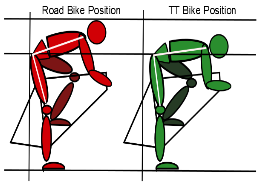

If you're new to cycling, you may feel the position on a road bike a bit unnatural. Stay relaxed and practice riding in low-traffic areas, and soon your body, and brain, will adapt to this position. You will adapt to it slowly.
The Stance
Start seated. Keep your back straight and shoulders down + relaxed so your lungs can fill with air. Relax your arms, with your elbows bent, your hands resting comfortably on the handlebar top. Avoid a death grip on the handlebars. To get power from your glut (buttock) muscles, lower your upper body toward the top tube by bending at hips. In the standing position, have your butt over the saddle + your weight (your belly button) centred over the bottom bracket.
There are three riding situations:
- Neutral or Flat Terrain; This is the most common. Your hands are on top of the hoods near the brakes + gear shifters. You are able to turn your head, have light pressure on your hands + feel comfortable for extended periods of time. Keep your shoulders broad + relaxed and your chest forward.
- Slopes - Descending or Ascending
- Descending; Lower your torso forward and move your hands to the lower handlebars - called the "drops". Shift your weight slightly back in your seat to give you more traction on the rear wheel.
- Ascending; Get into easier gear early, keep breathing deep + steady. Alternating between sitting and standing uses all your muscle groups. Move your hands to the hoods and push against them for leverage
While ascending its OK to.
- Go at your own pace - don’t go at speeds that are uncomfortable to maintain.
- Get off and walk if needed. When remounting, make sure you’re in an easy gear.
- Zig-zag if needed.
3. Cornering
- Mostly guide the bike around curves by leaning the frame and shifting your weight in the direction you're turning. If going very slowly you may need to turn the wheel.
- Look ahead, through, and around the bend.
- When you look far ahead, your bike and body will naturally veer in the correct direction
- Make a wide arc as you cruise around the corner. Start on the outside of the curve, aim for the apex of the corner and head back to the outside of the lane on exit.
- Position the inside pedal up + outside pedal down.
- Lower your speed before entering the turn. Avoid braking hard in the turn. To Top


- Jersey
- Shorts
- Shoes
- Helmet Arm, Leg and Knee Warmers
- Gloves
- Headgear
- Shoe Covers
Basic cycling etiquette
- Be Predictable:
- Stick to the Law: Always signal, make complete stops at signs, and wait for red lights
- Ride to the Left
- Turning Right: signal + move to the right side of the lane. Check for oncoming traffic and signal before moving over.
- Stay off footpaths:
- Ride as you would drive
- Use lights when low light conditions exist. A blinking light is more likely to make you visible
- Wear high visibility / reflective clothing
- Obey all the rules of the road.
- Cycle in full control of your bike.
Cycling Gear
Cycling professionals talk of staying "light" on the pedals as it keeps them ready for anything their competitors throw at them and keeps the chain tension low so its easy to change gear. This makes you nimble and efficient on the bike and allows you summon a burst of speed if needed.. It is also being relaxed on the bike.
Staying light on the pedals is all about spinning the pedals without too much resistance, in smooth, evenly distributed power circles at a cadence of 80-90 rpm.
If you lift slightly off the saddle, then your legs are pushing down hard - neglecting the rest of the stroke - called "pedaling squares"
Starting with your right foot in the 2 o'clock position, push down steadily. This uses the quads muscle in the front of the thigh. As you reach the bottom of the circle your heel should be level or below the pedal. Move / pull the shoe backward engaging your glut / buttock muscles.
Your left foot will be approaching the start of the power position, ready to push down. Your right foot should continue to apply pressure as it pulls up the right pedal to the top through the 8 to 11 o'clock positions. This will take some pressure off the down-stroke for the other leg. Complete the circle by pushing forward from 11 - 2 o’clock using your calves and gluts. Back to Top
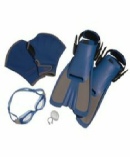
The ‘Swim For A Mile Challenge’ is a programme you can start anytime. You can find details at your local pool about classes and coaches or look at www.swimireland.ie,
Link to Swim Ireland
Link to Speedo Improver Programme: To Top
- Choose the Correct Lane - ‘slow,’ ‘medium,’ or ‘fast’ lap swimming. Pick a lane you feel comfortable in
- The lane sign may also indicate the direction of swimming within the lane – clockwise or anti-clockwise.
- If you want to overtake someone, you may do so, as long as the opposite side of the lane is free for you to pass. Allow other swimmers overtake at end of lanes - be aware.
- Give the swimmer in front some space - at least a quarter of the the length of the lane.
- If you feel you are faster than most people in a lane, step up to the faster lane.
- Some pools designate certain lanes for specific strokes
- Most pools don’t allow diving into the lap lanes.
- Never sit on the lane lines. To Top
The right foods for serious cycling is important. On the bike, they give you energy; off the bike, they help repair and recharge your muscles.
Carbohydrates should be your main energy source.
Protein is needed to rebuild your muscles so that your effort on the bike makes you stronger for next time.
Fat is an excellent source of fuel, giving you the ability to cycle longer and harder without crashing from low blood sugar. It also keeps you from getting hungry. Go for natural sources of it, like olives, nuts, seeds, and avocados.
Long moderate intensity cycling stimulates the body to preferentially use fats as the energy source and so is a great way of losing (fat) bodyweight
- A tyre lever (or two)
- A spare tube patch, glue, and emery cloth (a patch kit)
- Cash
- CO2 and tube inflator
- ID/insurance card / debit card
- A small multitool
- A hand pump for backup duty
- Lights
- Bike computer to give you speed, distance etc
Saddle Bag Stuff
Good running technique will help
- make your runs more efficient,
- feel less tiring,
- reduce your risk of injury and
- be more enjoyable.
Avoid striking the ground hard with your heel or forefoot first. Landing on the middle of your foot is the safest way to land for most recreational runners. Your foot should land below your hips – not right in front of you.
How to Run

Finding Time and Keeping on Track
If you take on more exercise you must commit to it. This is great for your health but requires effort and dedication.
Identify any potential barriers that could get in the way and work out in advance how you’re going to deal with them.
Commit some time, and keep to it until it becomes part of your conscious planning of your day / week.
Keep a record to remind you of the benefits and your progress. Expect some blips – they will happen!
If you’re feeling under the weather – particularly if you have a temperature – do not run.
Lapsing is not a failure. If you falter, take a breath and start afresh!
When getting a sports bra for the first time resist the temptation to buy online - go to a retailer to try on different styles and be fitted correctly.
Look for bras with high-support elements such as moulded cups, underwires, padded straps, and multiple hooks.
The following are worth considering::
- The Band: It should be made of wide elastic material so it can support your breasts without causing back bulges or riding up when you lift your arms.
- The Shoulder Straps: They should be wide and padded so they don’t dig into your shoulders.
- The Cups: To limit movement, the cups must completely cover your breasts (without leaving any creases or gaps).
- The Underwire: It should sit on your ribs so it doesn't dig into your breasts or under your armpits.
- The Front Band: The centre of the bra should sit on your breastbone, squarely between your breasts.
If you are larger than a DD bra, you may need a compression bra for some double-bra layering. This will help hold everything in place.
Below is a couple of videos about the correct fitting of a sports bra
Have a new bike? Get a professional Bike Fitting to see if you need to adjust these parts.
- Stem - The stem affects how far you have to reach for the handlebar and is probably the most commonly adjusted part.
- Seat Post - Adjust the height for your comfort.
- Saddle - The seat is another commonly adjusted part. Some are more suitable for male / female users. They can be adjusted forward and backward as well.
- Cables - your brake and shifter cables may need to be replaced with longer ones if other adjusted make them tight. To Top
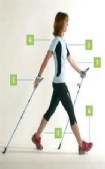
The key to Nordic walking is that as the pole pushes down and back, your body is pushed upwards and forwards giving you a gliding walk with posture. It’s based on natural gait and walking rhythm. The gives an efficient natural walking pattern
Nordic walking originated as summer training for cross-country skiers in Finland. These days, people can be seen all over walking with their poles – winter and summer.
Ireland’s first Nordic walking club is The Dublin Phoenix Nordic Walking Club (www.nordicwalkers.ie) was set up in 2008. A short instruction course is recommended to learn how to use the walking poles with good technique.
The key difference between regular walking and Nordic walking is the extra upper body workout. The poles exercise muscles in the arms, shoulders, chest, abdomen, back and neck as they are held at an angle to the rear as you walk. The poles distribute the effort on to all four limbs so giving you a full body workout. You forget you’re doing exercise as you walk and talk
Nordic walking poles are designed, adjustable in height and are attached to your wrists with Velcro strips. You place the poles into the ground behind you as you walk – the left pole hits the ground as your right foot advances and vice versa. The poles give the upper body a gentle workout as you walk. The poles are also very useful on rough terrain.
This activity attracts an older age group and make it ideal for those who are retired.
Nordic walking is a recommended physical activity for those recovering from breast cancer, lung or cardiovascular problems, joint replacements and some chronic pain conditions. It is also suitable for those keen to lose weight. To Top
For more information please see http://www.nordicwalking.ie





Mon - Fri 9.30am - 8.30pm


3A Barrack Close, Barrack St., Ennis, Co. Clare V95 X437

065 6840757
| Health+Safety Services |
| Sports Clubs+Teams Services |
| Standing Posture |
| Sitting Posture |
| Childhood Posture |
| Using Portable Devices |
| Normal Walking |
| Running |
| Running Drills Videos |
| Muscle Energetics |
| General Fitness |
| Losing Body Weight |
| Gaining Body Weight |
| Weight Loss Programmes |
| Start to Run |
| Start to Swim |
| Start Cycling |
| Start Nordic Waliking |
| Rehab of Tensdons |
| Loading of Tendons |
| Non Specific LBP |
| Posture |
| Intervertebral Disc |
| LBP Treatment |
| Non Specific Neck Pain |
| Neck Care Advice |
| Hamstring Strain |
| Ankle Sprain |
| ACL Injury |
| Joint Replacement |
| Shoulder Dislocation |
| Tennis Elbow |
| Wrist fracture |
| Fractured Knuckle |
| Selecting a Racquet |
| Racquet Grip Size |
| Racuet Sport Injuries |
| Training for Racquet Sports |
| Ski + Board Injuries |
| Injury Videos |
| Injury Prevention |
| Preventing Injury in Musicians |
| Irish Dancing |
| Preventing Dance Injury |